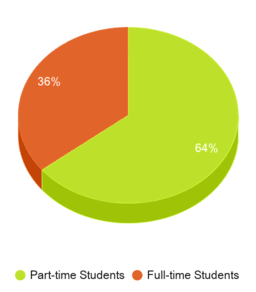- As one of the City Colleges of Chicago, Richard J. Daley College shares in the vision and mission of the District. In addressing the diverse community of the southwest side of Chicago, Daley College provides opportunities for higher education, professional growth and cultural enrichment. Daley College is committed to high quality, affordable programs which are responsive to the educational and career needs of the community.
School Highlights
City Colleges of Chicago-Richard J Daley College serves 8,067 students (36% of students are full-time).
The college's student:teacher ratio of 27:1 is higher than the state community college average of 21:1.
Minority enrollment is 92% of the student body (majority Hispanic), which is more than the state average of 53%.
Quick Stats (2025)
- Enrollment: 8,067 students
- In-state tuition: $6,460
- Out-state tuition: $7,891
- Student:teacher ratio: 27:1
- Minority enrollment: 92%
- Source: Integrated Postsecondary Education Data System (IPEDS)
Top Rankings
City Colleges of Chicago-Richard J Daley College ranks among the top 20% of public schools in Illinois for:
Category
Attribute
Affordability
Debt For Students
School Overview
The teacher population of 302 teachers has stayed relatively flat over five years.
City Colleges of Chicago-Richard J Daley College
(IL) Community College Avg.
Carnegie Classification
Associate's Colleges: Mixed Transfer/Career & Technical-High Nontraditional
Associate's Colleges: Mixed Transfer/Career & Technical-High Nontraditional
Institution Level
Less than 2 yrs
At least 2 but less than 4 years
Institution Control
Public
Public
Total Faculty
302 staff
227 staff

School Calendar
Student Body
The student population of City Colleges of Chicago-Richard J Daley College has grown by 23% over five years.
The student:teacher ratio of 27:1 has increased from 16:1 over five years.
The City Colleges of Chicago-Richard J Daley College diversity score of 0.36 is less than the state average of 0.69. The school's diversity has declined by 6% over five years.
Total Enrollment
8,067 students
3,270 students

Student : Teacher Ratio
27:1
21:1

# Full-Time Students
2,874 students
1,007 students

# Part-Time Students
5,193 students
2,747 students



# Enrollment Undergraduate
806 students
328 students
# Full-Time Undergraduate Students
2,874 students
1,007 students

# Full-Time Graduate Students
n/a
43 students
# Part-Time Undergraduate Students
n/a
3,310 students
# Part-Time Graduate Students
n/a
18 students
Total Dormitory Capacity
n/a
132 students
% American Indian/Alaskan
n/a
n/a

% Asian
1%
6%

% Hispanic
79%
26%

% Black
10%
13%

% White
8%
47%

% Hawaiian
n/a
n/a

% Two or more races
1%
3%

% Non Resident races
n/a
1%
% Unknown races
n/a
4%


Diversity Score
0.36
0.69

College Completion Rate (Students who graduate in less than 4 years)
0.3028%
0.4%

College Completion Rate (Students who graduate in 4 years or more than 4 years)
n/a
0.38%
Average Graduate Earnings (10 Years)
$31,400
$31,800

Tuition and Acceptance Rate
The public in-state tuition of $6,460 is less than the state average of $7,875. The in-state tuition has declined by 43% over four years.
The public out-state tuition of $7,891 is less than the state average of $10,847. The out-state tuition has declined by 45% over four years.
In-State Tuition Fees
$6,460
$7,875

Out-State Tuition Fees
$7,891
$10,847

% Students Receiving Some Financial Aid
85%
82%

Median Debt for Graduates
$3,625
$8,187

Median Debt for Dropouts
$2,868
$4,618

Acceptance Rate
n/a
89%
SAT Reading
n/a
390
SAT Math
n/a
360
SAT Writing
n/a
355
ACT Composite
n/a
17
ACT English
n/a
17
ACT Math
n/a
17
Source: 2024 (or latest year available) Integrated Postsecondary Education Data System (IPEDS)
School Notes
- The man who laid the plans and broke the ground was Chicago's six-term mayor, Richard J. Daley. It was his commitment to the residents of the Southwest community that made the college a reality, and so it was fitting that a week after his death, the school was renamed Richard J. Daley College. Mayor Daley did not live to dedicate the new building when its doors opened in 1981, but his ideals and aspirations for the people of Chicago are embedded in its walls. With a full-time faculty of 81 members and a student body of 4,500, Daley College continues the unbroken tradition which began at Lane and Crane in 1911, of offering university-bound students a solid liberal arts education in their own neighborhoods at a cost working people can afford. Moreover, it continues to respond to the changing needs of Chicago and its people by augmenting traditional studies with the technical, career and occupational curricula for our times, and everything from accounting to telecommunication technology. Daley College also provides an important community service by offering free literacy and bilingual English classes to more than 5,000 students in its Adult Education Program. Typical of institutions of higher learning, Daley College has a broad offering of courses in liberal arts and science. In addition to transfer and pre-professional programs the college offers vocational, technical, and occupational programs for entry level or career advancement. Pre-credit programs to bring skill levels up to college standards are afforded along with Continuing Education, Adult Basic Education, the GED program, and English as a Second Language courses to serve the needs of people who have deficiencies in background which hamper the pursuit of their academic and career goals. A wide array of special events at the college and the offerings of the Cultural Arts Committee provide enrichment activities and to a large degree provide affordable cultural experiences for the community. Daley's students study, work, and play in a facility equipped with a 60,000 volume library; laboratories for accounting, chemistry, physics, biology, mathematics, languages, microcomputer programming, electronics and word processing; ample classroom space; a gymnasium, pool, cafeteria and student activities center; and complete student services from advising to financial aid. Daley's graduates transfer to colleges and universities all over Illinois where they are welcomed as most desirable juniors, or join the work force of Chicago where they are among its most productive and enlightened citizens. Many of the promises implicit in the name of our community college have been fulfilled at Daley, and, if the past is precedent, many more will be.
Frequently Asked Questions
How much does City Colleges of Chicago-Richard J Daley College cost?
City Colleges of Chicago-Richard J Daley College's tuition is approximately $6,460 for In-State students and $7,891 for Out-State students.
What is City Colleges of Chicago-Richard J Daley College's ranking?
City Colleges of Chicago-Richard J Daley College ranks among the top 20% of community college in Illinois for: Least expensive tuition, Average community college minority breakdown and Least debt for graduating students.
In what neighborhood is City Colleges of Chicago-Richard J Daley College located?
City Colleges of Chicago-Richard J Daley College is located in the West Lawn neighborhood of Chicago, IL.
Recent Articles

Obtaining Your Bachelor's Degree at a Community College
Explore the evolving landscape of community colleges offering bachelor's degrees, addressing affordability, accessibility, and workforce needs.

A to Z of Community College Certificates and Courses
From business and healthcare to technology and skilled trades, the article showcases the breadth of options available to students seeking to enhance their knowledge, develop new skills, or pursue career advancement.

What is a Community College?
This comprehensive guide explains what a community college is, its history, and its role in higher education. It covers the types of programs offered, differences from four-year colleges, benefits of attending, and important considerations for prospective students, providing valuable insights for those exploring educational options.





